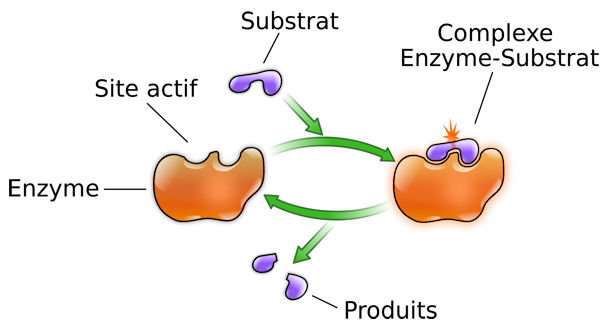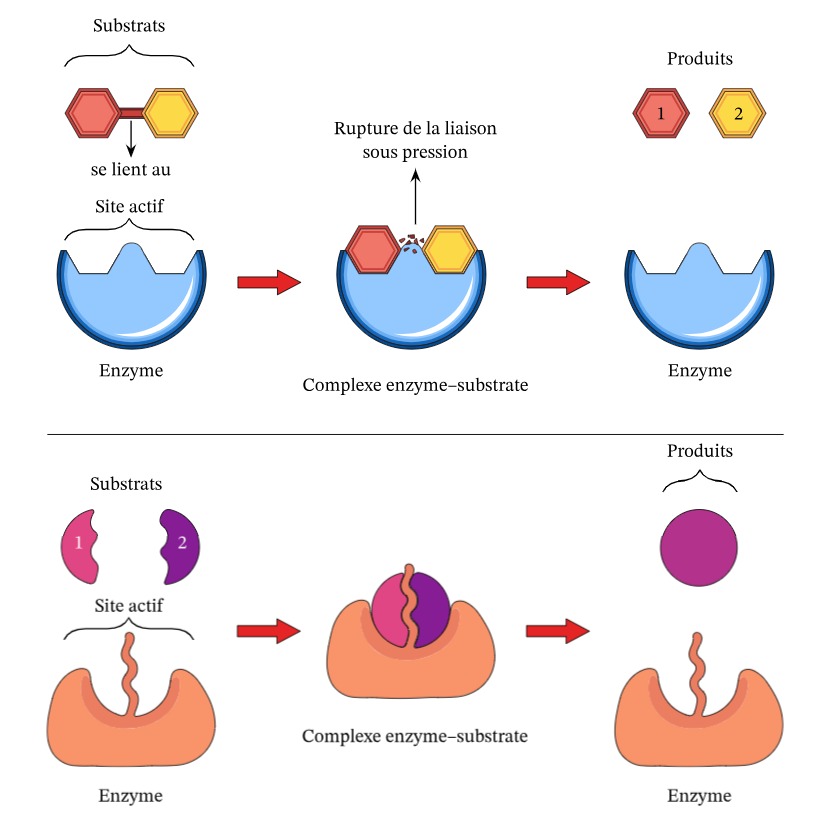I will try in this article to share with you what enzymes are, these marvelous biological catalysts, without resorting to overly scientific explanations. To understand how enzymes work, you need to see them as specialized body workers humans, workers that we at Biovie have decided to nickname "metabolic auxiliaries", because enzymes do not provide any nutrients (they are not dietary supplements); they help us optimize the body's functions, whether metabolic or digestive, through a large number of biochemical reactions."
What exactly are enzymes ?
In living organisms, enzymes "are proteins that" accelerate a large number of types of biochemical reactions and chemical reactions necessary for life. Imagine a production unit where each machine (enzyme) is designed to perform a specific task quickly and efficiently. These machines (enzymes) are crucial for breaking down macronutrients into smaller, absorbable units, converting nutrients into energy, repairing our cells and organs, and many other vital functions.
Each enzyme is involved in a very specific biochemical reaction., It is unique and only works on a particular type of "piece," meaning a substrate molecule with which it has a complementary shape, like two 3D puzzle pieces for its specific enzymatic reaction. This is referred to as substrate specificity. The enzyme attaches to this piece and transforms it, thereby allowing complex reactions to occur quickly and without wasting energy. It's a bit like a key that opens a specific lock: the enzyme (key) only works on its substrate (lock).. This is what is called enzymatic activity, and it is what characterizes the difference between the living and the inanimate.
(source: Wikipedia)
Enzymes are also reusable and recyclable., they are not "worn out" by their use. This is, in fact, the very definition of a catalytic reaction: the substance responsible for the reaction remains intact at the end of the reaction. After transforming a substrate, they are free to start again with another. Thanks to this, Even in small quantities, they can carry out many reactions in a short amount of time., and when they are in their optimal operating environment, particularly at body temperature, they are very fast.
In terms of health, enzymes are essential. They are involved in everything from the digestion of food to the repair of DNA. When they do not function properly, it can cause serious problems, such as genetic diseases, autoimmune disorders, and even certain cancers.
Finally, it is important to know that the enzymes we produce and those we consume in food play different roles, but all are important for a healthy metabolism.
To better understand, One can compare enzymes to very efficient personal assistants in the body.. They take care of everything, from converting food into usable energy to managing cellular waste. It's as if each metabolic process has its own dedicated assistant, ensuring that everything runs smoothly and at a steady pace.
The fascinating aspect of enzymes is their extreme precision. They do not just work on any chemical reaction; they target specific reactions. This specificity prevents metabolic chaos by ensuring that the right reactions occur in the right place and at the right time.
Enzymes also play a key role in our health by regulating metabolic pathways. They act as speed regulators, accelerating or slowing down reactions according to the needs of our body. When this system is disrupted, imbalances can occur, leading to health problems.
For example, if a key enzyme is deficient or absent due to a genetic mutation, this can lead to a metabolic disease and cascading problems. Conversely, if an enzyme is too active, processes can literally spiral out of control, potentially leading to autoimmune diseases or even certain types of cancer.
In summary, enzymes are essential players in the complex theater of our metabolism. Their role in maintaining our health is as crucial as it is invisible, discreetly orchestrating a multitude of vital processes that allow us to live, grow, and stay healthy.
Roles of enzymes in the body
Enzymes, these metabolic helpers, play an indispensable role in our bodies, as we have seen. They accelerate and facilitate numerous biochemical reactions essential to our daily lives. Here are some concrete examples of their action:
Glycolysis: This biochemical reaction is somewhat like breaking down a complex piece (sugar, glucose) to extract energy (ATP) and other useful components. Several enzymes work together here, and if they do not function properly, it can lead to problems such as low blood sugar levels, muscle weakness, and other metabolic disorders.
Digestion: Imagine specialized tools (digestive enzymes) that, by breaking chemical bonds, reduce food into small molecules (nutrients) that our body can use. These reactions begin at the very start of the digestive tract, thanks to enzymes produced by the salivary glands. For example, proteins are broken down into amino acids. If these enzyme-tools are defective, digestion is compromised, which can lead to issues such as malnutrition, abdominal pain, bloating, and diarrhea, and most importantly, poor assimilation of what we eat, regardless of the quality of the food.
DNA repair: DNA repair enzymes act like true maintenance technicians, identifying and repairing various damages found on our genetic material. If they do not function properly, it can cause genetic mutations, increase the risk of cancer, and accelerate aging.
Urea cycle: This process converts toxic ammonia into a less dangerous substance (urea) that our body can easily eliminate through the kidneys. The enzymes involved in this process are crucial; their dysfunction can lead to an accumulation of ammonia in the blood, severely harming the brain and other organs.
Synthesis of hemoglobin: Hemoglobin, carried by our red blood cells, is essential for transporting oxygen throughout the body. If the enzyme responsible for its production is deficient, it can cause anemia, leading to fatigue, weakness, shortness of breath, and paleness.
In short, enzymes are key players in vital processes, whether it involves anabolic reactions (building molecules) or catabolic reactions (breaking down molecules)., and their proper functioning is essential for our health and well-being.
Enzymes and temperature
At high temperatures, the internal bonds of enzymes break, and the enzyme loses its shape. (we call this their three-dimensional structure); their activity ceases, and living cells become dead cells. At this temperature, a food loses its intrinsic food enzymes. This explains why foods cooked beyond a certain temperature are less digestible than raw foods, because cooked foods no longer have these internal enzymes. The human body, rather than benefiting from them, must therefore produce new ones to digest the food properly, which of course has a biological cost. In other words, digestive enzymes are destroyed by the heat of cooking, and our body can no longer benefit from them, and enzymatic reactions no longer take place. However, at temperatures lower than body temperature, the enzymes remain active.
Enzymes are sensitive to heat, much like complex and delicate ice sculptures. Each enzyme has a specific three-dimensional shape, held together by fragile bonds. This shape is crucial for their function, as it allows them to bind to their substrates and accelerate chemical reactions. Like a puzzle piece sensitive to heat, which would irreversibly deform by melting above its melting temperature:
Influence of Temperature: Each enzyme has an "optimal temperature" at which it functions best, often close to the body temperature of the organism from which it originates. For example, human enzymes are optimal around 37°C. At this temperature, they are flexible enough to perform their tasks efficiently.
Effect of Temperature Drop: When it gets colder, enzymes slow down. They move less and interact less with their substrates, which decreases the rate of the reactions they catalyze. Fortunately, low temperatures generally do not permanently destroy enzymes.
Effect of Temperature Increase: On the other hand, when the temperature increases, the enzymes first become activated and function more quickly, but If the temperature rises too much, they start to deform and lose their ability to function. This loss of structure (denaturation) is irreversible. ; once destroyed, the enzyme cannot repair itself. This is the main reason why we advocate for food to be as uncooked as possible, in order to preserve the enzymatic capital of our foods.
In our food, enzymes are almost always destroyed during cooking or industrial processing, as these processes use temperatures well beyond their heat tolerance threshold. This temperature varies depending on the type of enzyme; for example, pectinase is deactivated around 50°C, amylase around 70°C, and protease and catalase around 60°C.
Finally, a slight increase in body temperature, such as during a fever, can boost our immune system. This additional but non-destructive heat accelerates the enzymes involved in our body's defense, thereby helping to fight infections more effectively and quickly. Certain key enzymes of the immune system, such as interferons, can even be more active at slightly higher than normal temperatures.
Coming up: we will discuss two specific categories of enzymes in two other articles; digestive enzymes and metabolic enzymes.
Sources:
Berg, J.M., Sure, please provide the text you would like to have translated from French to English., J.L., Gatto, G.J., & Stryer, L. (2015). Biochemistry (8th ed.). New York: W.H. Freeman and Company.
It seems like your message got cut off. Could you please provide the complete text you would like translated from French to English?, J.G., & Pratt, C.W. (2013). Fundamentals of Biochemistry: Life at the Molecular Level (4th ed.). Hoboken, NJ: John Wiley & Sons.
It looks like you haven't provided the full text for translation. Could you please provide the complete text in French that you would like to be translated into English?, D.L., It seems like the text you provided is incomplete or not in a full sentence. Could you please provide more context or a complete sentence for an accurate translation?, M.M. (2017). Lehninger Principles of Biochemistry (7th ed.). New York: W.H. Freeman and Company.
Sharma, H. K., Prasad, K., & Dinesh, M. R. (2011). Biochemistry and Biotechnology of Pectinases: A Review. International Journal of Food and Fermentation Technology, 1(1), 1-15.
P. M. Nielsen (1994) Functionality of exogenous enzymes in dough systems. In: Journal of Cereal Science, 20(1): 47-57.
V. C. Pandey et al. (2000) Enzyme technology in food processing. In: Journal of Food Science and Technology, 37(2): 123-135.
A. K. Mondal et al. (2012) Catalase Activities, Stability and Kinetics: A Comparative Study. In: Journal of Microbiology, Biotechnology and Food Sciences, 1(5): 1205-1214.
Berg, J. M., Tymoczko, J. L., & Stryer, L. (2002). Biochemistry (5th ed.). New York: W.H. Freeman. (Chapter 8, "Enzymes: Basic Concepts and Kinetics")
Isaacs, A., Lindenmann, J., & Valentine, R. C. (1957). Virus interference. II. Some properties of interferon. Proceedings of the Royal Society of London. Series B - Biological Sciences, 147(927), 268–273. doi: 10.1098/rspb.1957.0048.







